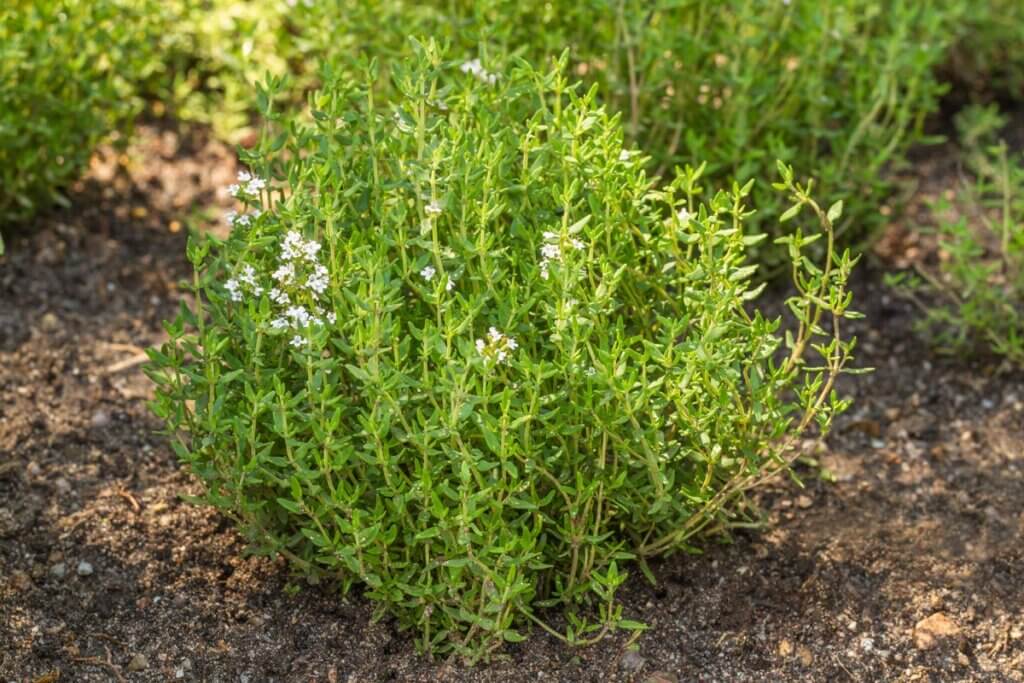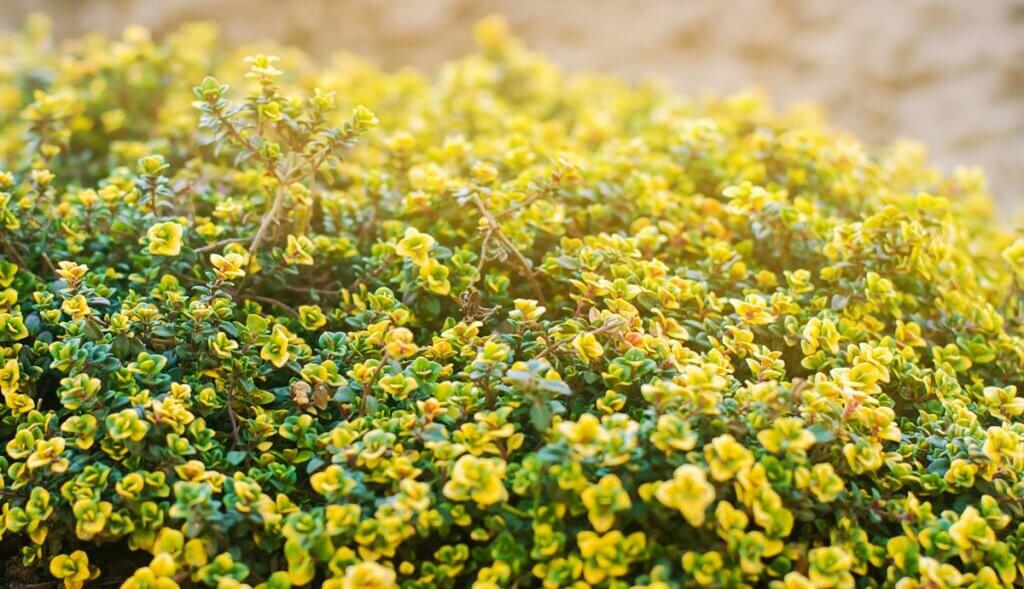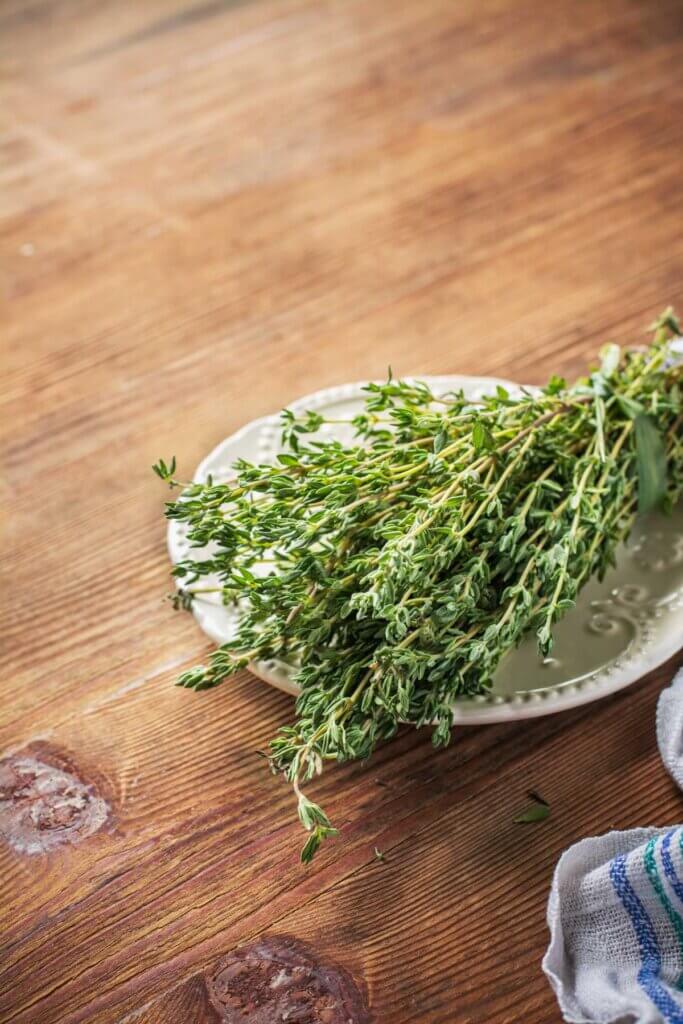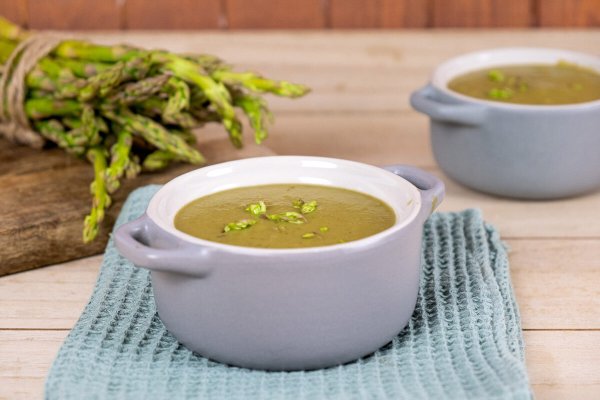You can easily start growing thyme from seed or a cutting, inside a pot in the kitchen or outside in the garden. This tutorial can get you started.

Thymes’ native roots originated in sunny, warm Mediterranean regions and crept the rocky crags of Scotland, with its diverse culinary and medicinal properties now enjoyed and used around the globe.
Why I Love Growing Thyme
“Thyme to Garden” is a cute play on words that makes me think of the joy I find in preparing and planning for the gardening season.
Our seasons here in the Pacific Northwest are specific and “thymely” (I couldn’t resist.) We have longer winters and shorter spring and summer months, so having a plan ahead of time can make a significant difference in the success of my old-fashioned cottage garden.
Thyme is a good companion in the vegetable garden, it grows well in container gardens, displays beautiful delicate flowers that attract pollinators, and just like growing rosemary and growing sage, thyme doubles for culinary and medicinal purposes.
It’s important to note that I am not a certified medical practitioner. This post is not intended to diagnose or treat but is for informational purposes only. Please contact your medical care professional before introducing new herbal remedies into your wellness routine.

Varieties of Thyme
There are over fifty varieties of thyme, but the following are some of the most common varieties you will find growing in a home vegetable or herb garden:
- Common Thyme or English Thyme – Common thyme (Thymus Vulgaris) is the most commonly grown thyme plant. Great for growing in household planters and gardens.
- Creeping Thyme – Creeping thyme (T. Praecox) is often called “Mother of Thyme”; it’s a low-growing, ground cover option for rock gardens and borders. Homesteading Hack: Use the leaves sparingly in culinary dishes that need to simmer over time because of their deep flavor; the longer it simmers, the stronger it gets.
- Golden Lemon Thyme – Golden Lemon Thyme (Thymus x citriodorus Aureus) grows well in most gardens and has a pleasant, refreshing lemon fragrance and zesty flavor. Plus the yellow tips of the plant make a beautiful addition to any garden.
- Lime Thyme – Lime thyme (Thymus x citriodorus) is from the same family as lemon thyme. It has a lime scent and flavor often used in Indian cuisine.
- Wild Thyme – Wild thyme (Thymus serpyllum – L) grows in stony ground and open sandy grasslands from Europe to Romania; it’s hardy and prolific.
- Caraway Thyme – Caraway thyme (Thymus herba-barona-Loisel) is grown in Mediterranean regions. This variety is used in soups and stews, pairing well with garlic, adding the fragrance and taste reminiscent of caraway seeds.

Medicinal Uses for Thyme
Thyme leaves make a potent essential oil and dehydrate quickly to make tea. Its strong antiseptic, antibacterial and disinfectant properties provide many uses for this amazing herb.
- Antiseptic – You can make homemade tinctures with thyme leaves which contain the antiseptic compound thymol, and add it to your face wash, helping with skin blemishes and acne.
- Antibiotic Ointments – I make this homemade antibiotic ointment with thyme oil for our family’s cuts and scrapes. No more Neosporin in our household!
- Immunity – Drinking thyme leaf tea naturally boosts your immune system with vitamins and minerals, such as A and C, copper, iron and manganese.
- Cough and Congestion – You can add thyme essential oil to our home remedy for coughs and congestion. It helps reduce inflammation and mucus and alleviate coughing. Also, try steam inhalation by boiling some water, pouring it over fresh thyme, then breathing in the vapors to help clear congestion.
- Bacterial Infections – The antibacterial benefits of thyme as an herbal tea or capsule may help fight a bacterial infection.
- Yeast Infections – Thyme is antibacterial with vitamins and minerals to aid the body when it’s struggling with infections. Dehydrated, you can make it into herbal capsules or drink it as a tea to aid in fighting yeast infections.
- Aromatherapy – You can make essential oil from the leaves and use it as aromatherapy to calm the nerves and relax the body.

Culinary Ways to Use Thyme
Thyme is used in culinary dishes around the world. Mediterranean, Indian, American, Italian dishes and more use this herb to compliment their cultural cuisine. Homesteading Hack: A little goes a long way! Thyme has a very intense flavor, so do not overdo it, or it will overpower your dish.
- Beverages – Thyme adds an earthy, refreshing flavor to instant herbal iced tea and calms the body when consumed as a hot tea.
- Bread – Adding thyme with basil and oregano to herbed flatbread is one of our favorite variations for this no-knead bread dough.
- Sauces – Thyme is a flavorful addition to quick and easy pan sauces adding a delicious depth of flavor.
- Chicken – Adding fresh or dried thyme in this lemon reduction sauce with roasted chicken is fantastic; one of our family’s favorites!
- Beef – Whether it’s corned beef in a crock pot or canned beef stew, we enjoy the flavor of thyme in most beef recipes.
- Lamb – Thyme is fantastic with leg of lamb, lamb chops and one of our family favorites, an Irish lamb stew.
- Vegetables – Sprinkle fresh or dried thyme over your favorite vegetable recipes for a flavor boost.
- Salads and Dressings – We grow fresh greens year round; adding fresh thyme to the greens and mixing dried thyme into our homemade vinaigrette dressing complements each other so well.
- Main Dishes – Depending on the ethnicity of the dish you are preparing, thyme is good in pasta, rice, potatoes and meats, poultry, lamb and fish. It’s one of the best all-around culinary herbs!

What Is the Secret to Growing Thyme?
The thyme plant is adaptable and hardy, and due to its Mediterranean roots, thyme will thrive with plenty of sunshine and well-draining soil. So much so that thyme is considered a drought-tolerant plant.
My simple secret to growing thyme… keep trying until you find the right variety! Plant several varieties until you find one that grows well in your climate and conditions.
I initially planted five different varieties of thyme. Over the years, just one variety stood the test of time. However, it became so prolific it ended up providing all I needed, and there wasn’t a need to plant thyme again.

Growing Thyme
Thyme is a hardy perennial that companions well with brassicas, tomatoes, and strawberries. Intersperse with various other vegetables and herbs for a lovely display of little pink, white and lavender blooms and let it attract pollinators and deter pests.
Planting
- Seeds – Knowing how to read seed packets will help determine if you want to sow thyme seeds directly into the soil or start seeds indoors. If you start them indoors weeks before the last frost, learn when to pot up seedlings before planting the thyme in the garden for a good start.
- Spacing – Space your seeds or established young thyme plants 12 to 24 inches apart, depending on your chosen variety. This vigorous growing plant spreads readily and grows up to two feet in diameter according to the variety.
- Sun – Thyme likes plenty of sunshine, at least 6-8 hours daily.
- Soil – Thyme prefers well-drained soil with a pH level of 6.0 to 8.0. Homesteading Hack: Learn how to test your soil here! Thyme grows well in sandy, loamy and even rocky soil that is moist and slightly dried out between waterings. Only a little soil amending is needed; you can make organic compost to boost the soil before planting in the garden or side-dressing your plant once a year.
Growing
- Watering – Most varieties of thyme are drought resistant and prefer thorough watering after the top of the soil is completely dry. Thyme thrives under stress and produces a strong, pungent flavor and scent when the ground is not over-watered. Keep it slightly moist, and you won’t get root rot.
- Pests – Thyme is resistant to most pests and diseases, but it can become infected with rosemary beetles. Pick off the larvae so this pest doesn’t eat little holes in the leaves. Generally, this beetle can infest other herbs that grow alongside thyme, such as rosemary, sage and lavender.

Harvesting
- Clipping – Harvesting thyme couldn’t be easier. Pick and use the fresh green leaves of this perennial all season. The best time to reap your harvest is early summer before it flowers and when it’s most productive. Cut a few stems at a time to gather and enjoy all summer.
- Wintering Over – Trim thyme back after it’s flowered to promote new leaves and vigorous growth. You can harvest again in late fall and then give it a final trim, preparing it for the following spring.
- Storing – After clipping your thyme, wash it, pat it dry, and store it in a sealed container with a damp paper towel.

Preserving
After growing and harvesting, you can try different methods for preserving thyme to enjoy it all year long.
- Drying – Drying fresh herbs is my preferred method to preserve thyme. Once dried, you can store them in airtight containers and use them for up to a year. It gets us through the winter months when fresh thyme isn’t available.
- Freeze Drying – You can use a freeze dryer to preserve thyme. It will taste like fresh thyme when you reconstitute it. Learn the difference between freeze-dried and dehydrated foods to decide what is best for you.
- Freezing – You can freeze herbs like thyme in olive oil, lemon juice, or water in ice cube trays. Homesteading Hack: Decide how you plan to use your thyme before choosing the liquid you freeze it in.
- Preserving in Salt – You can preserve herbs in salt, and thyme works well with this method.

In The Homestead Kitchen
Thyme is a versatile addition to my kitchen and herbal medicine cabinet. The culinary and medicinal uses go far beyond what most herbs offer. This herb’s health benefits and flavor make it a go-to for our family when added to various cuisines.
Check out In the Homestead Kitchen Magazine if you want more inspiration on multiple uses for what you grow.
This subscription will give you access to our beautifully designed monthly digital magazine full of tips, recipes, step-by-step tutorials, and stories to guide and inspire you in your homestead kitchen.

Other Articles You May Enjoy
- Designing an Old Fashioned Cottage Garden
- Growing Oregano
- How to Grow Basil
- Growing Dill
- How to Grow Chives (Plant, Harvest, Preserve)
- How to Grow Cilantro
- Growing a Rosemary Plant
- How to Boost Your Immune System Naturally in 7 Simple Steps
- Home Remedies For Cough (For Babies, Toddlers & Adults)
- Instant Herbal Iced Tea Recipe
















